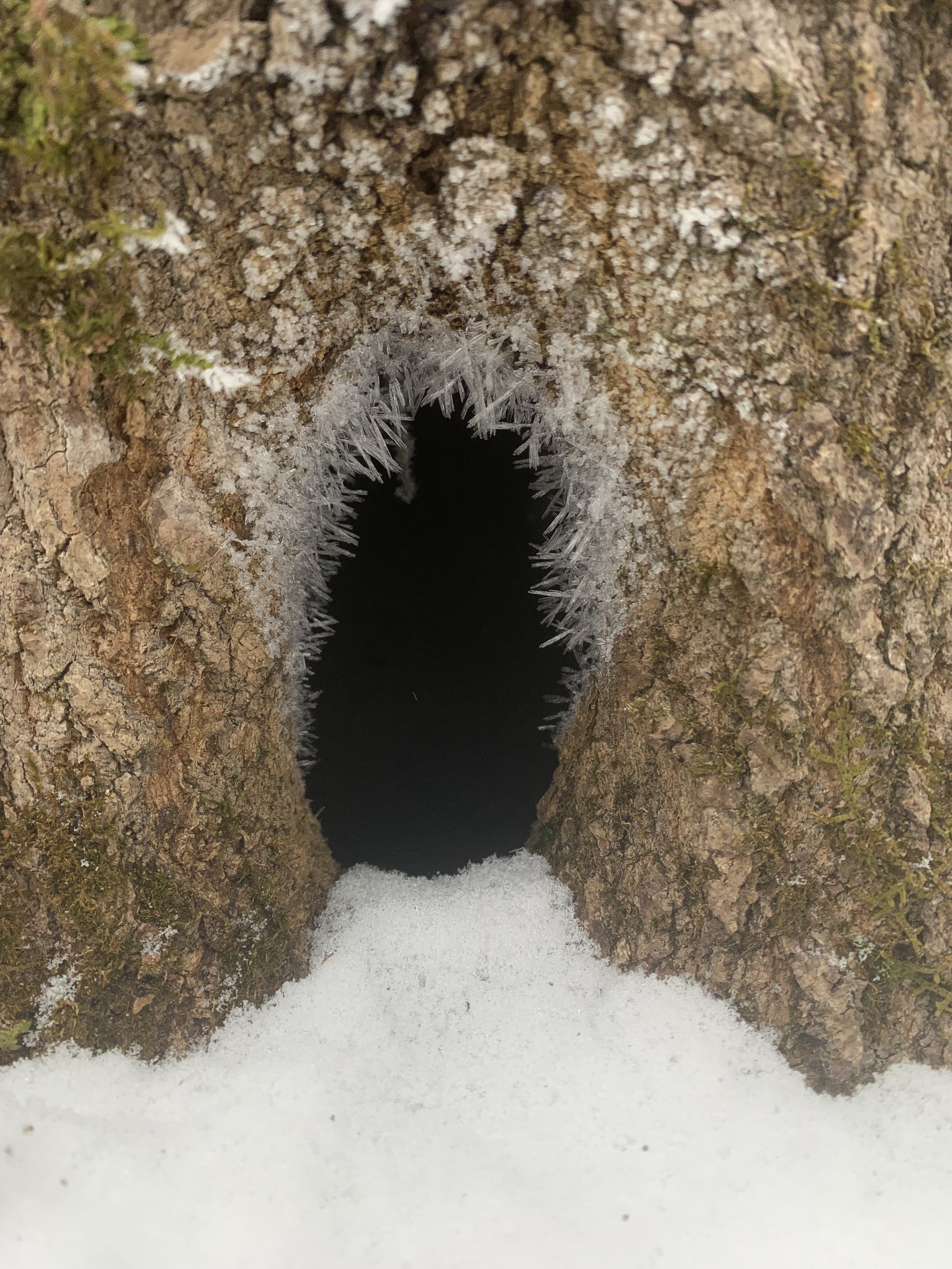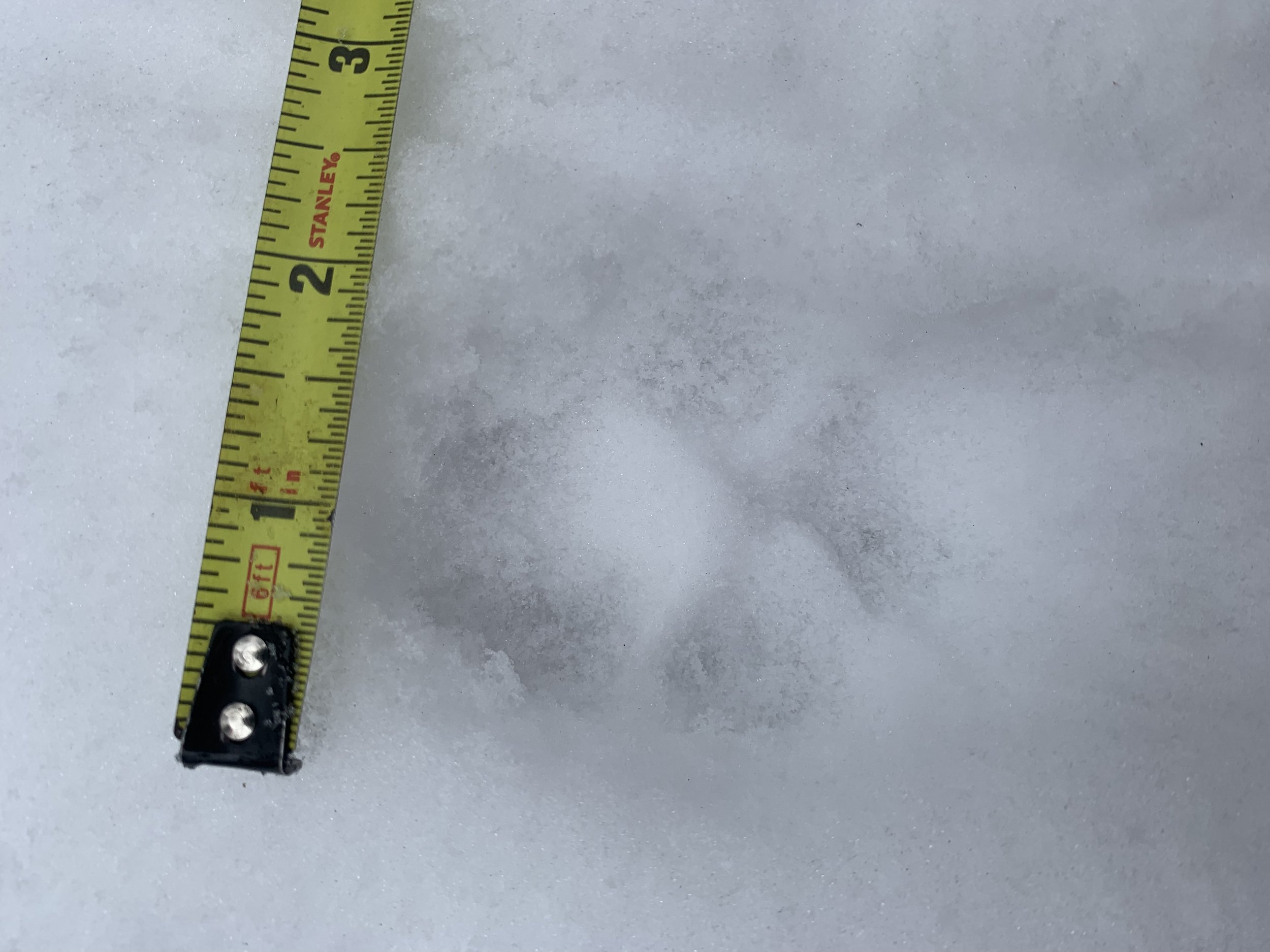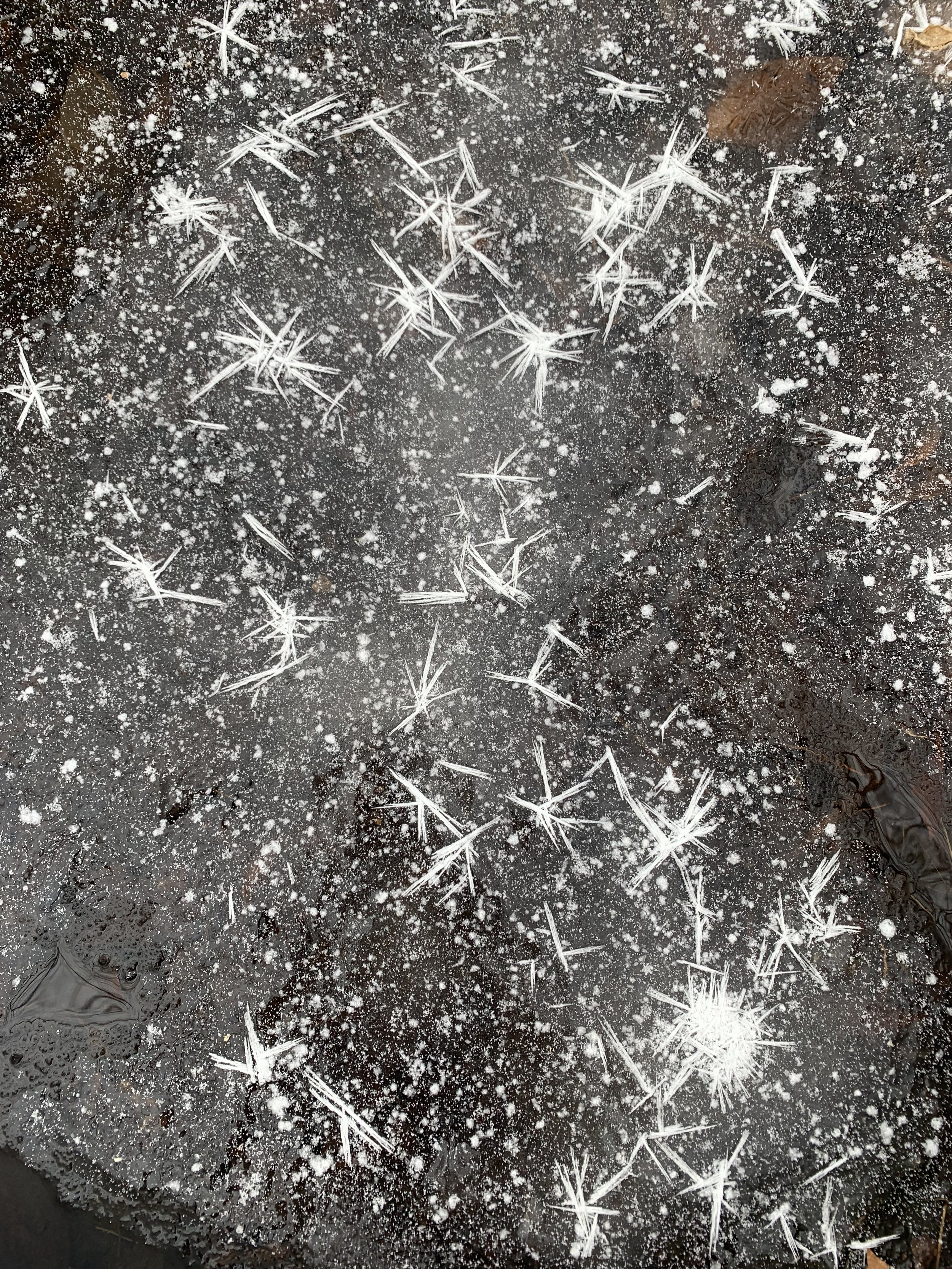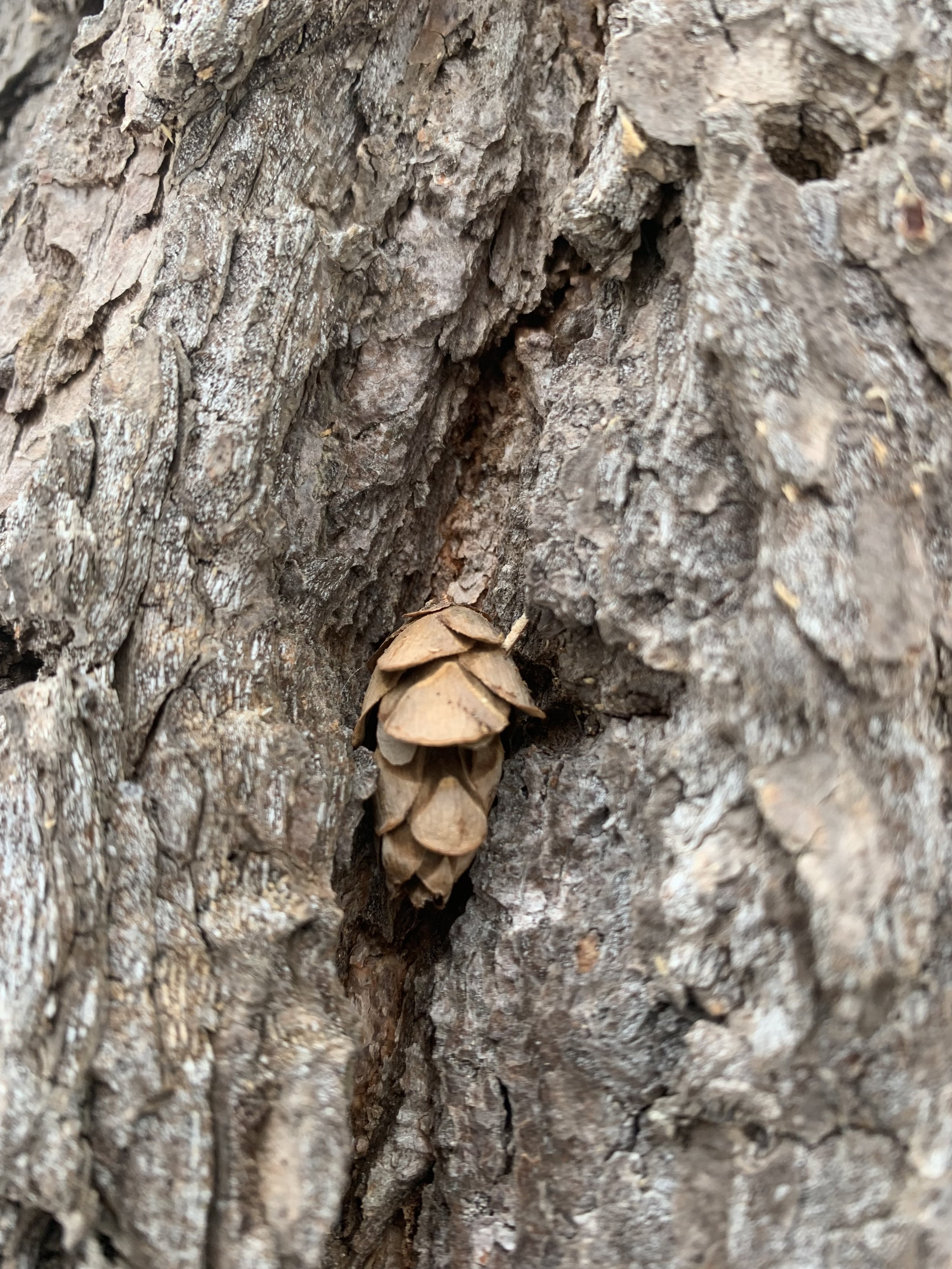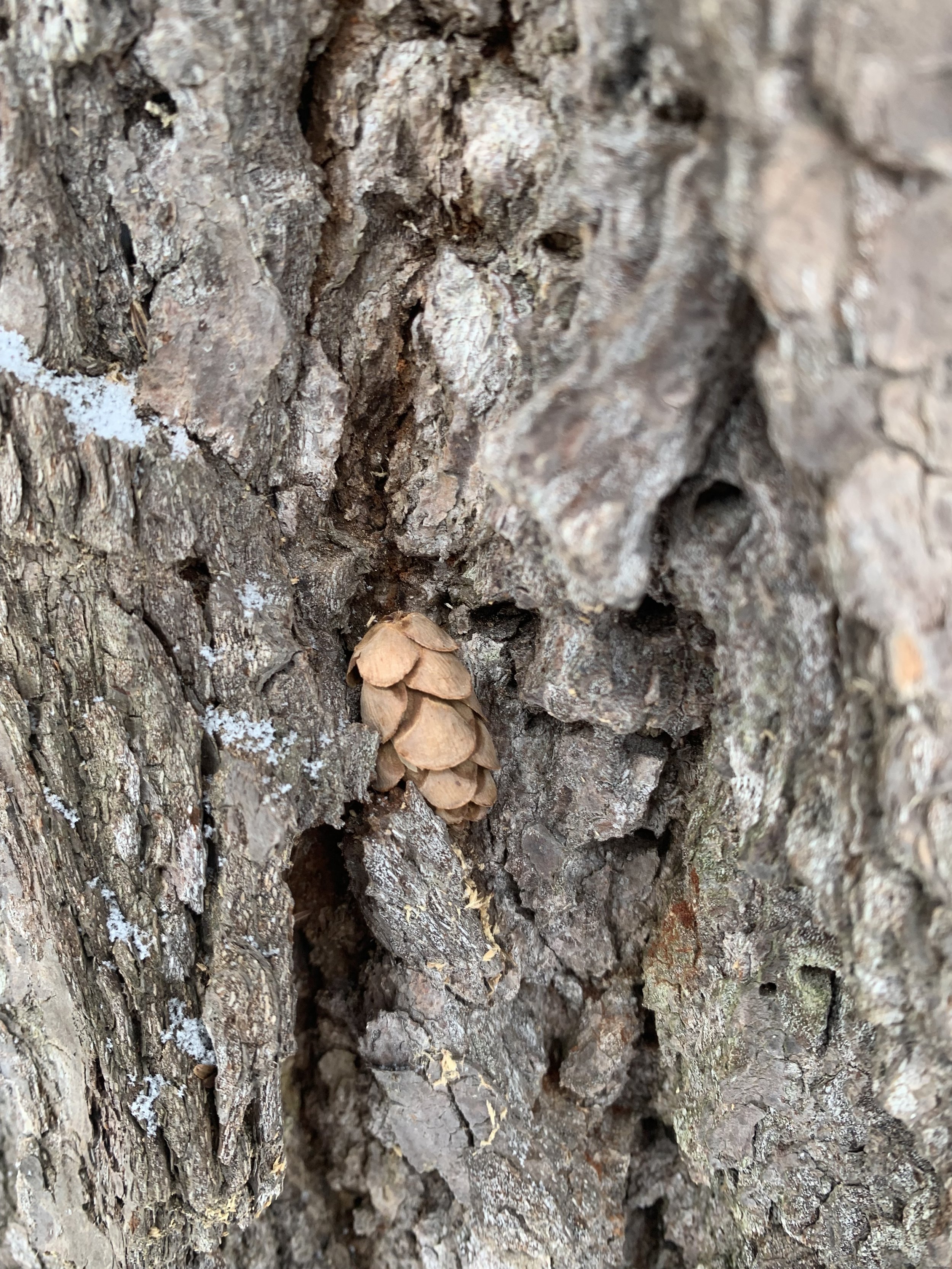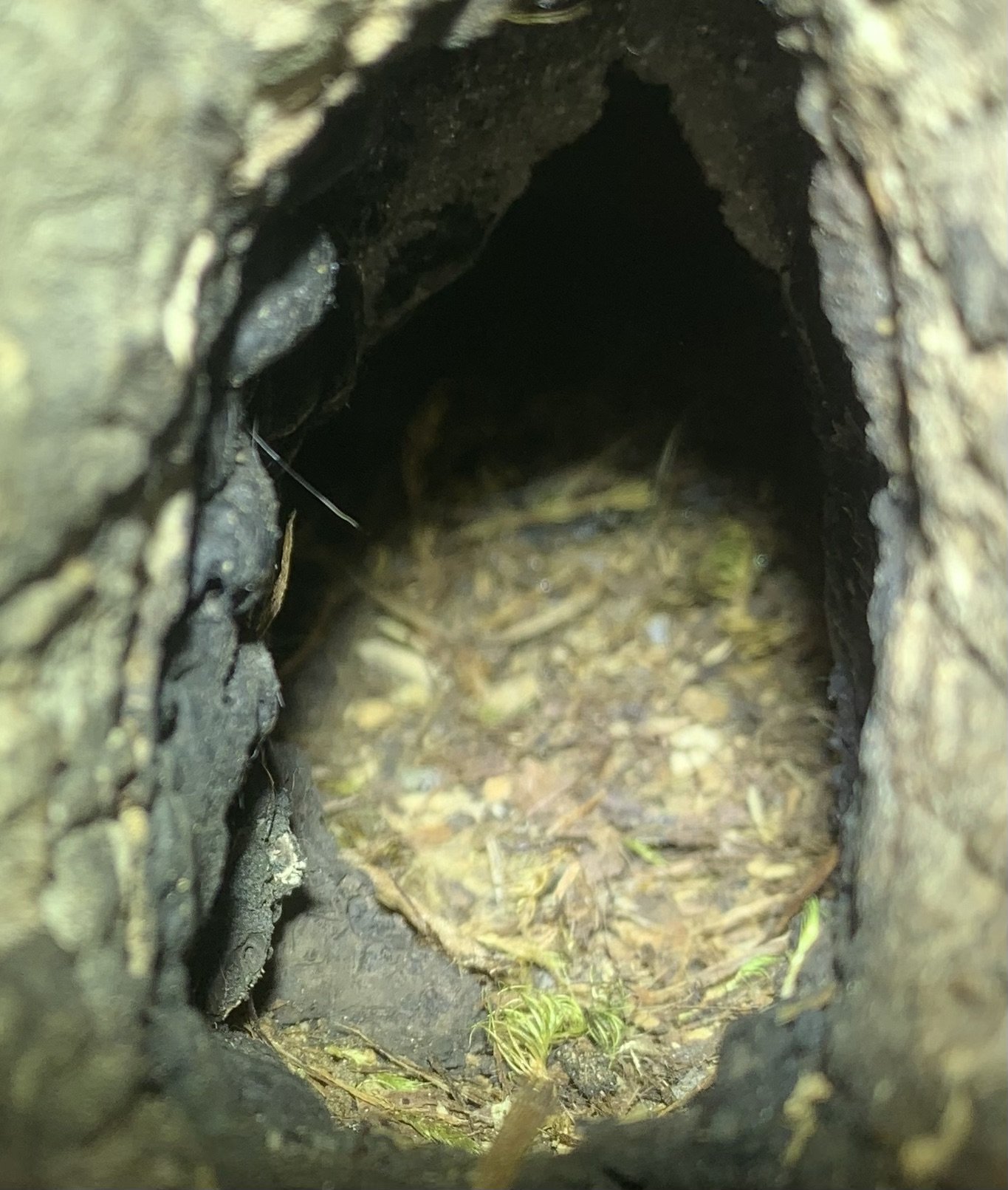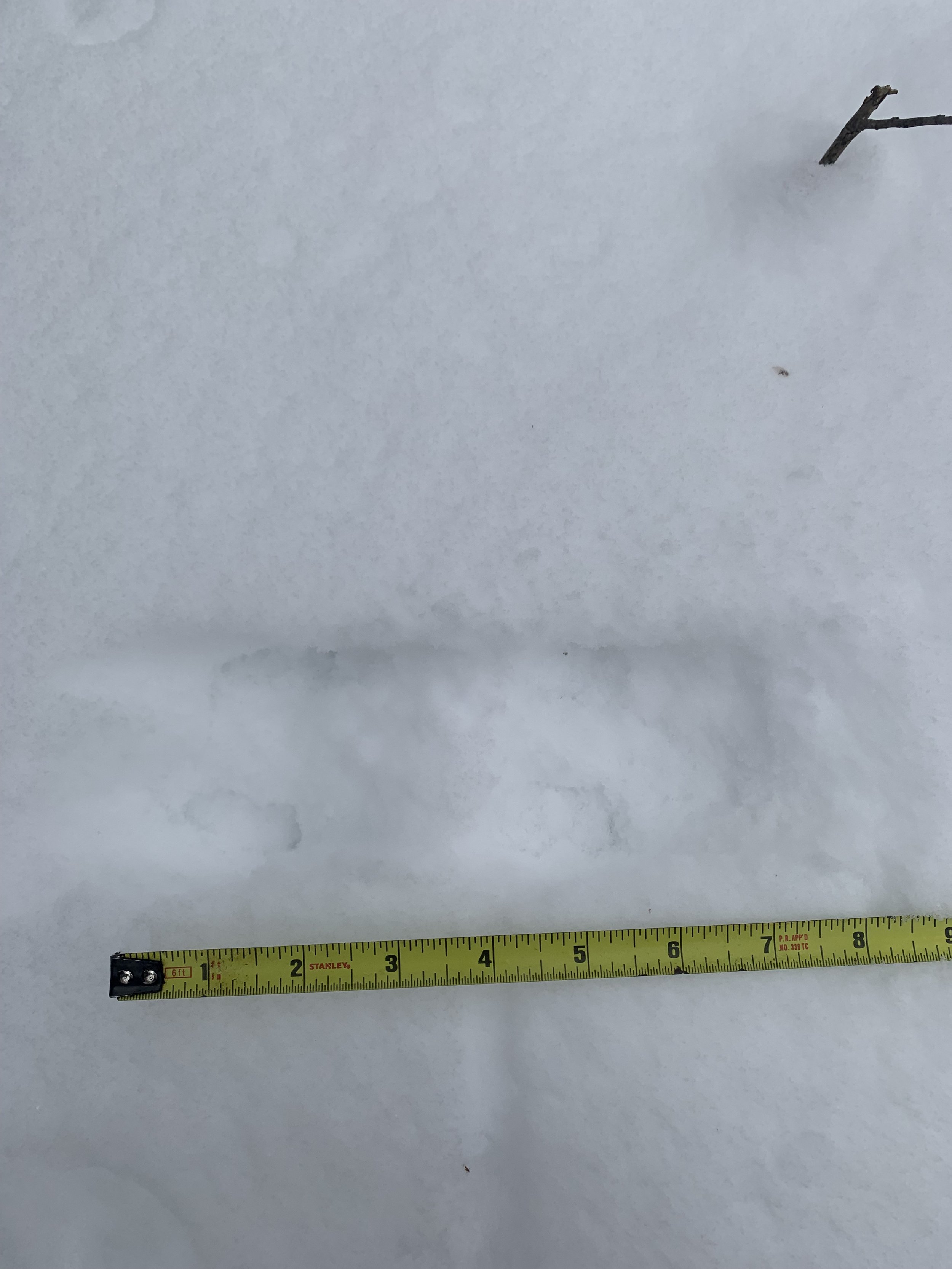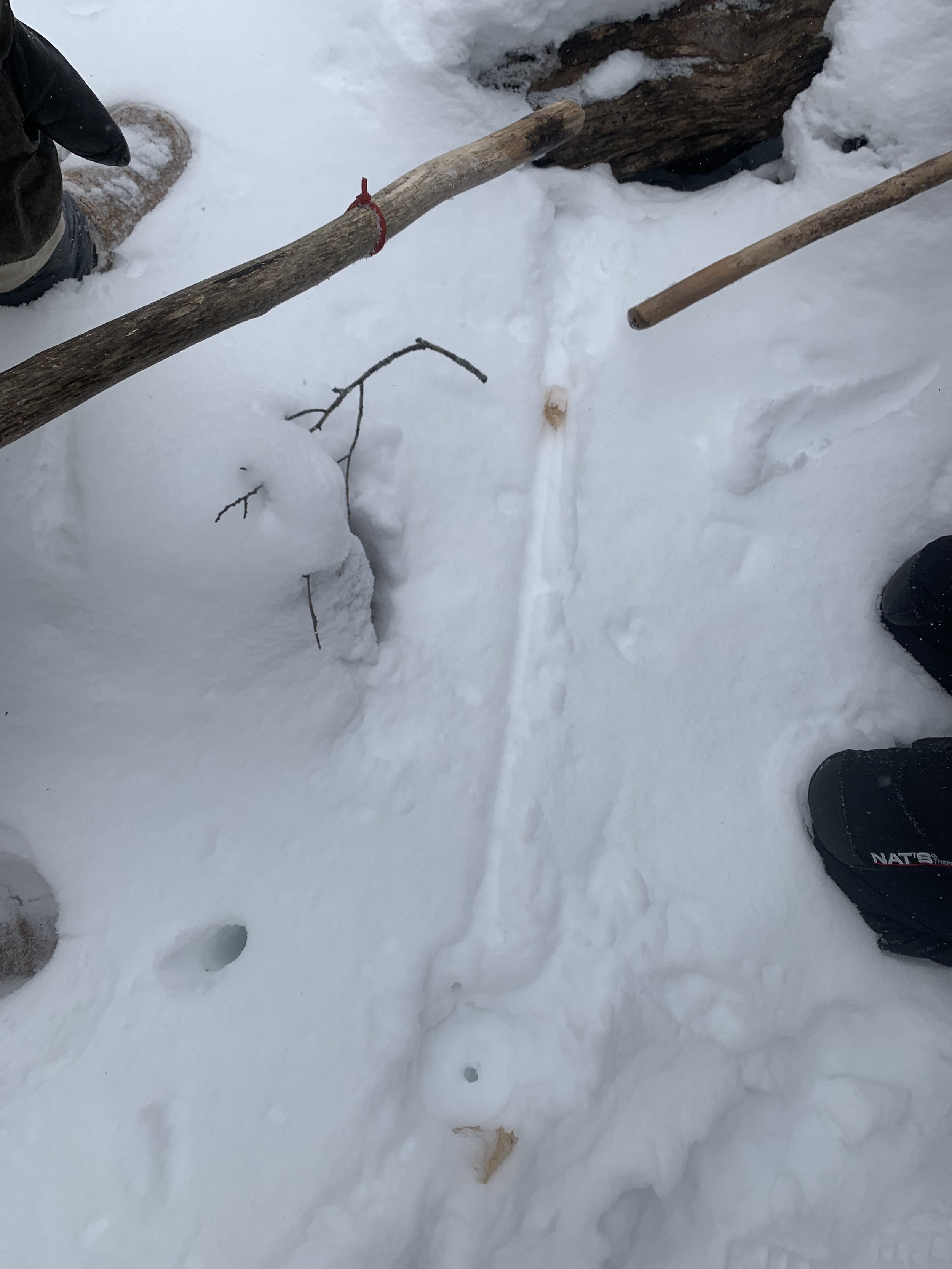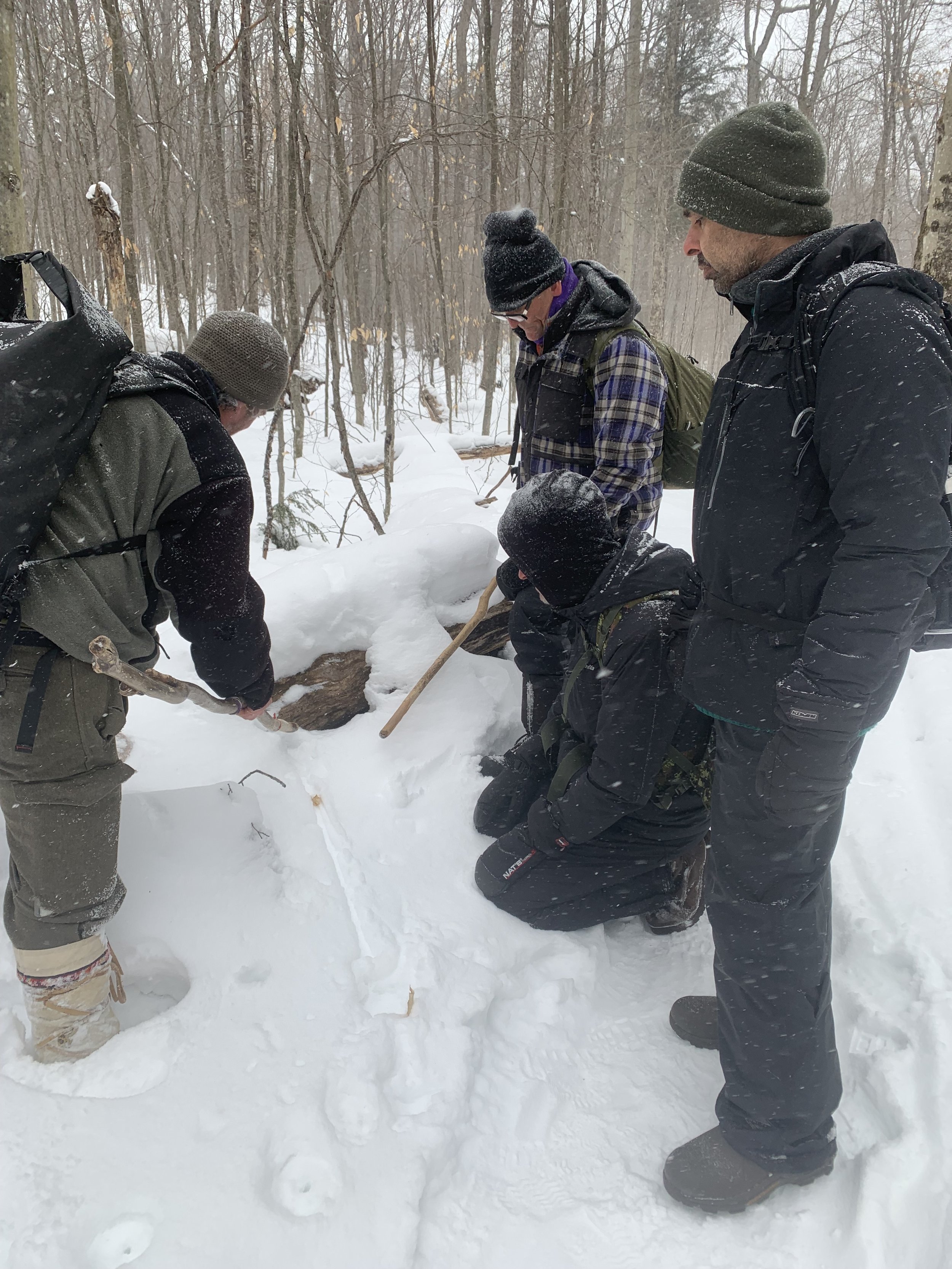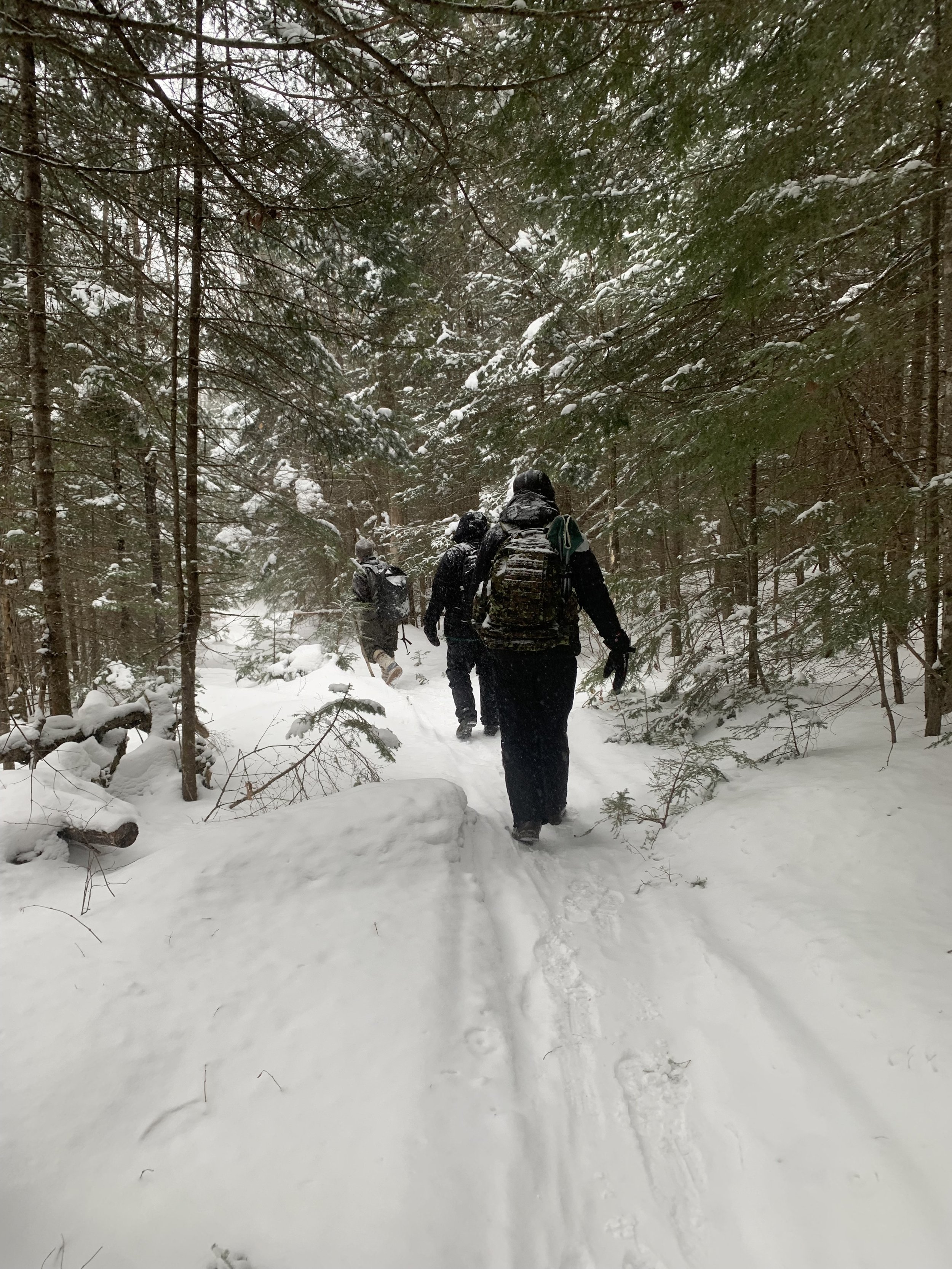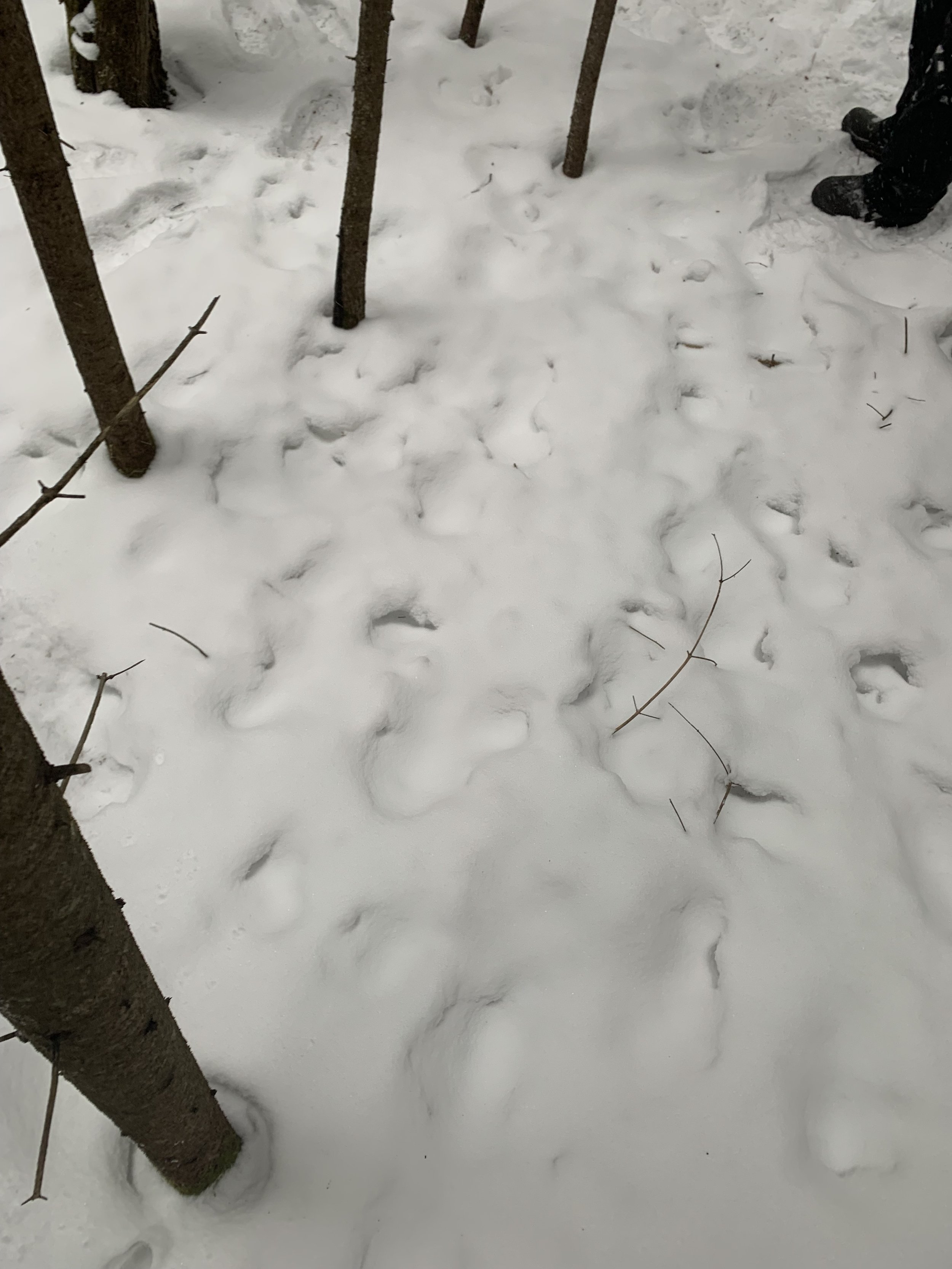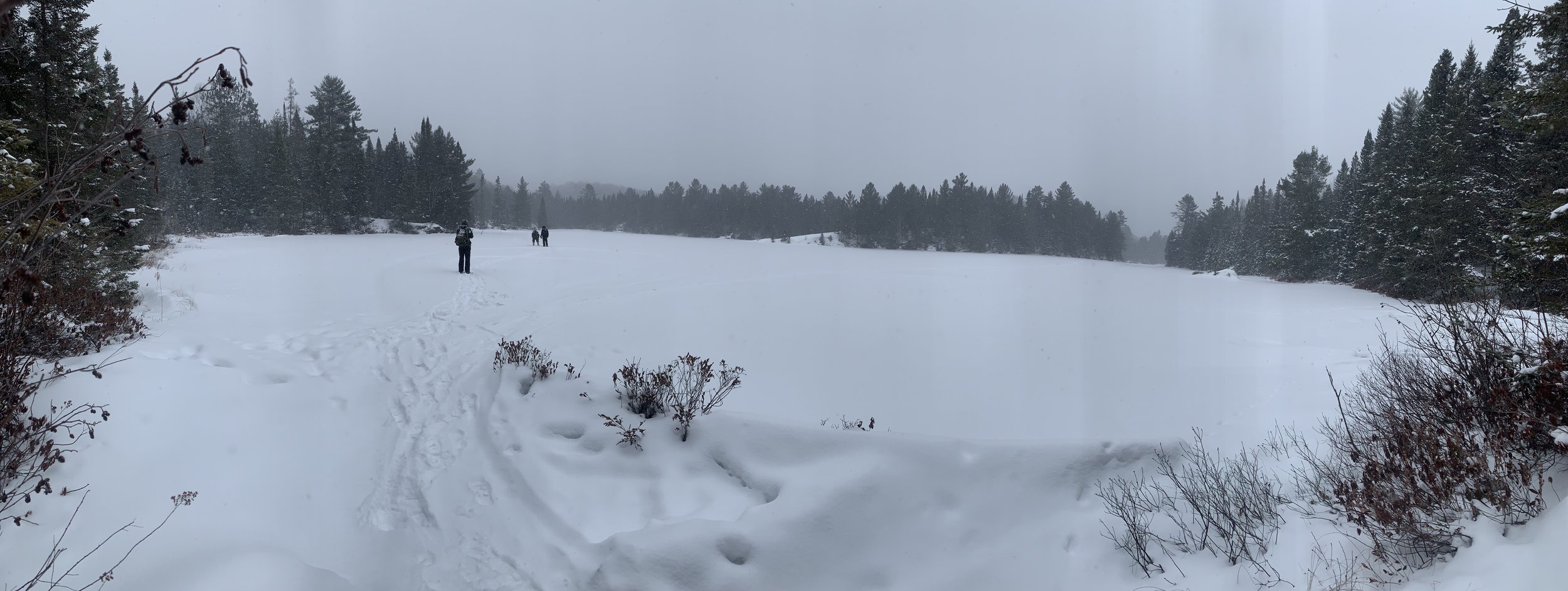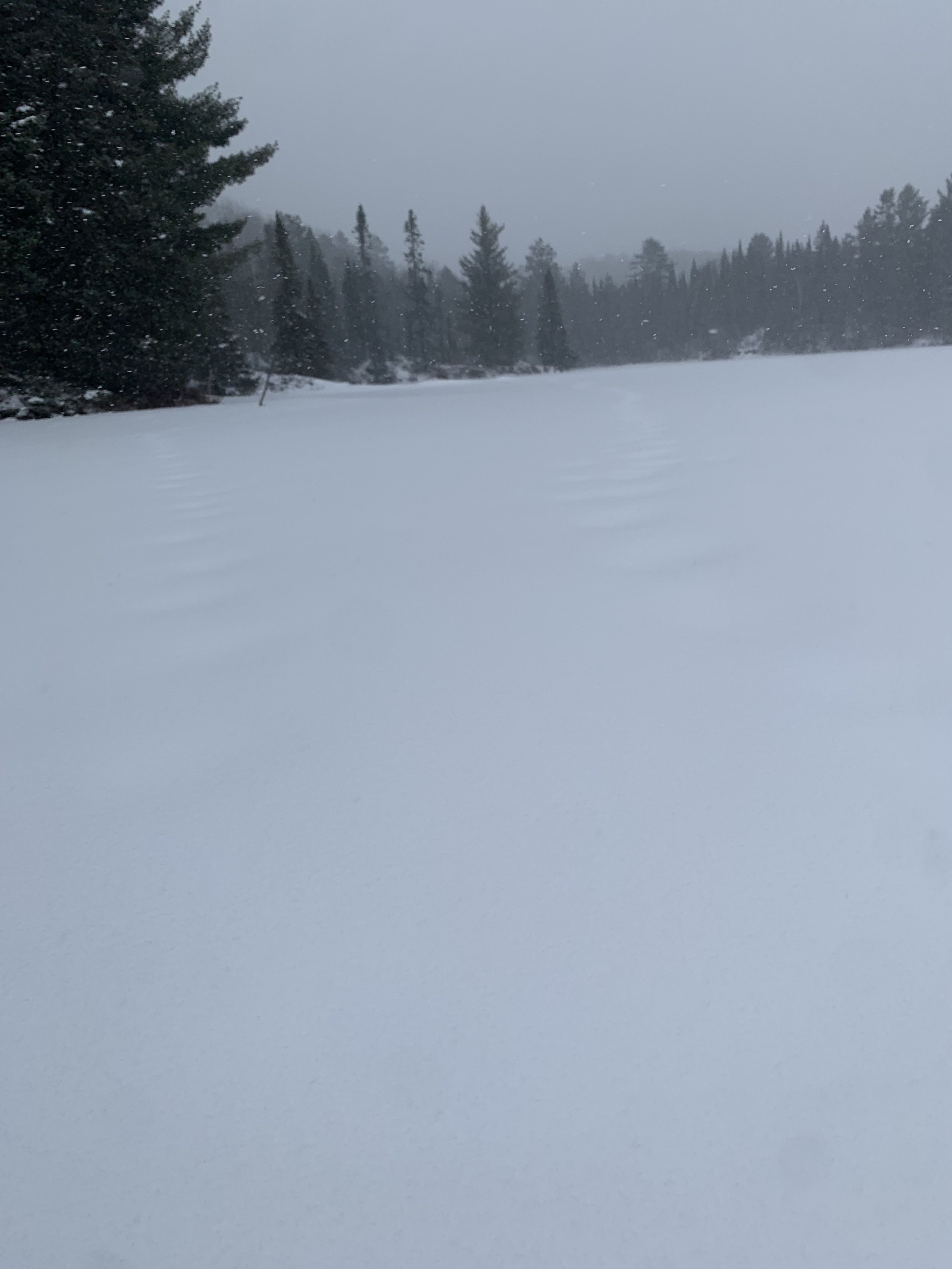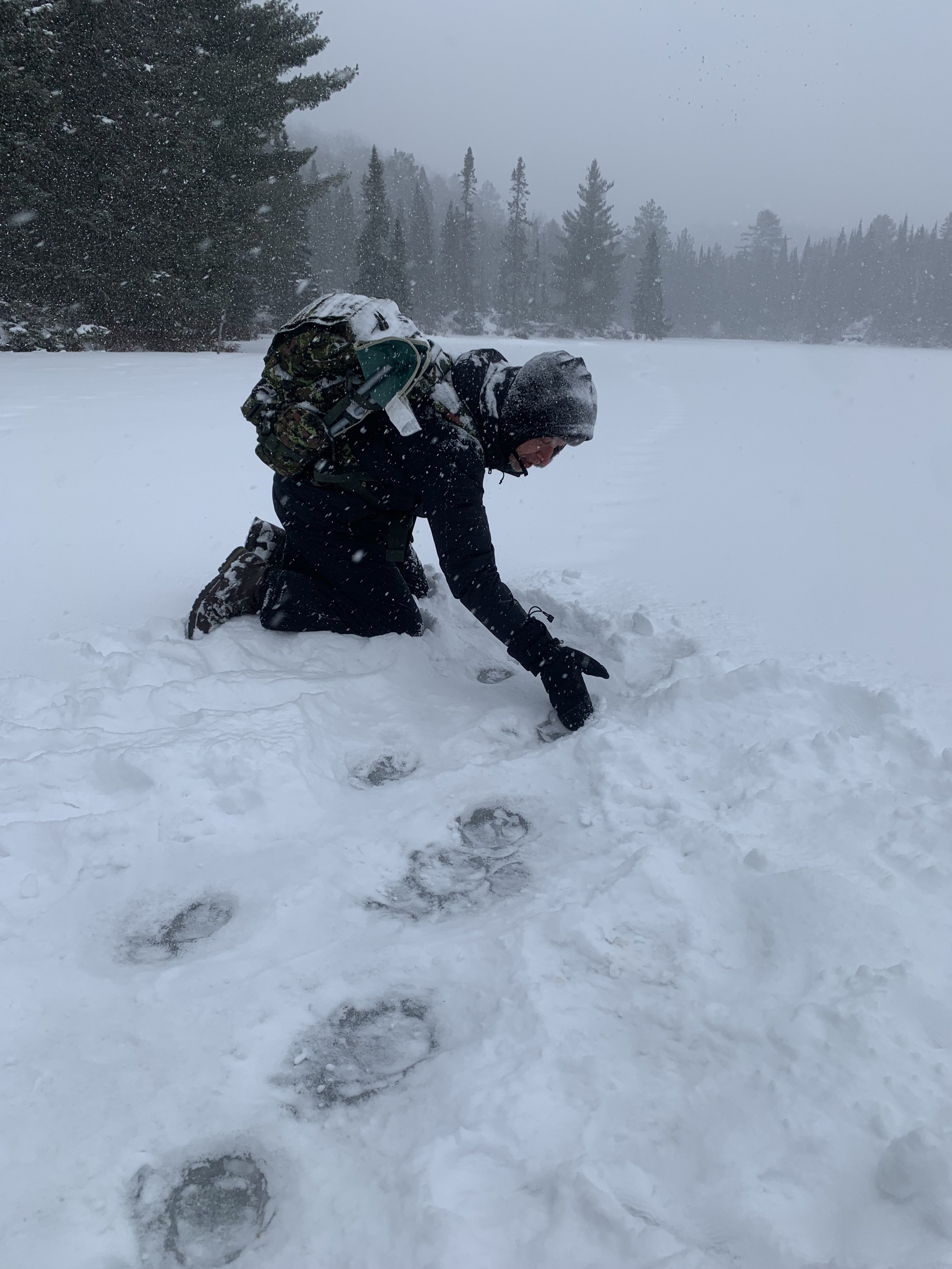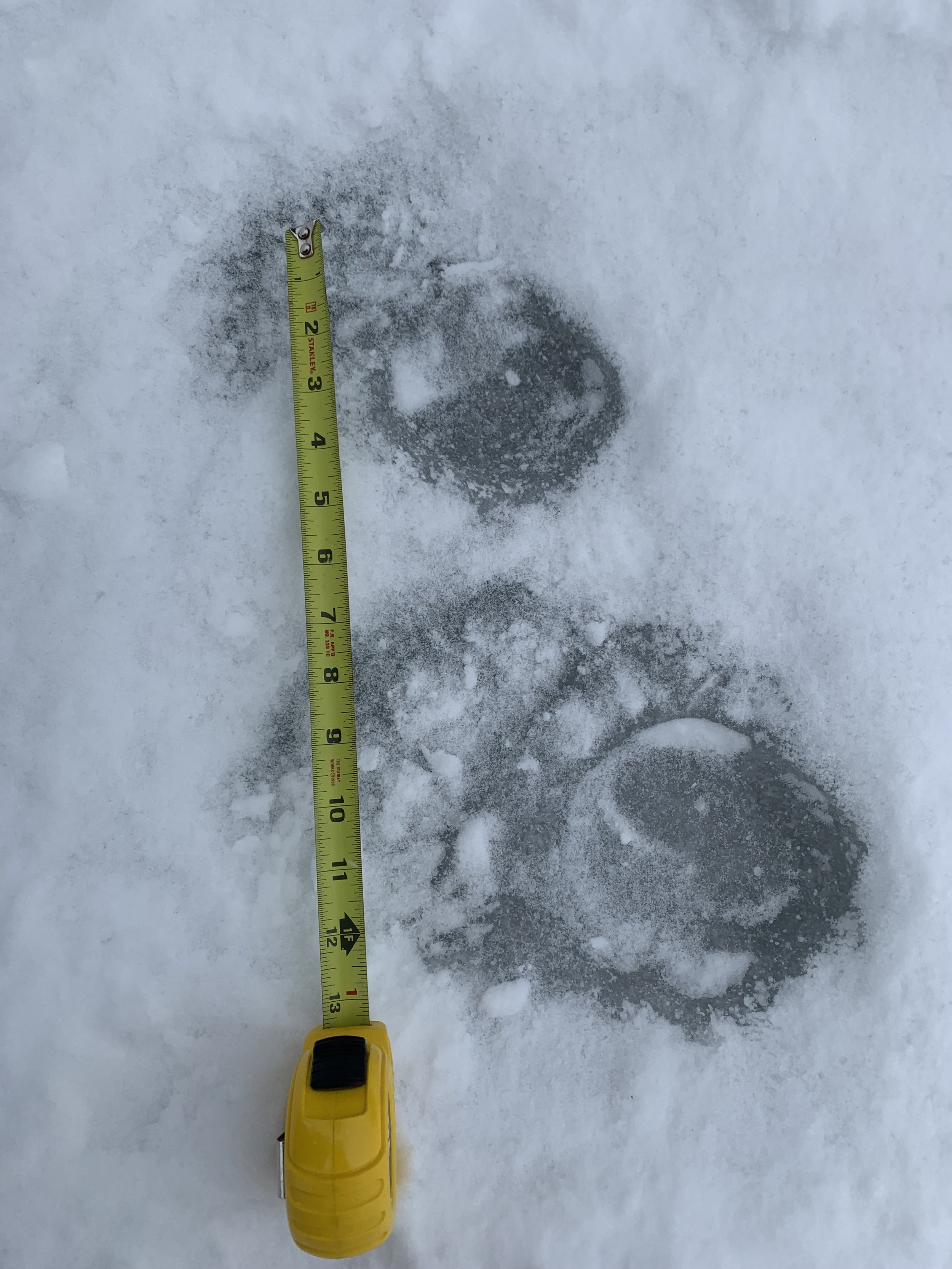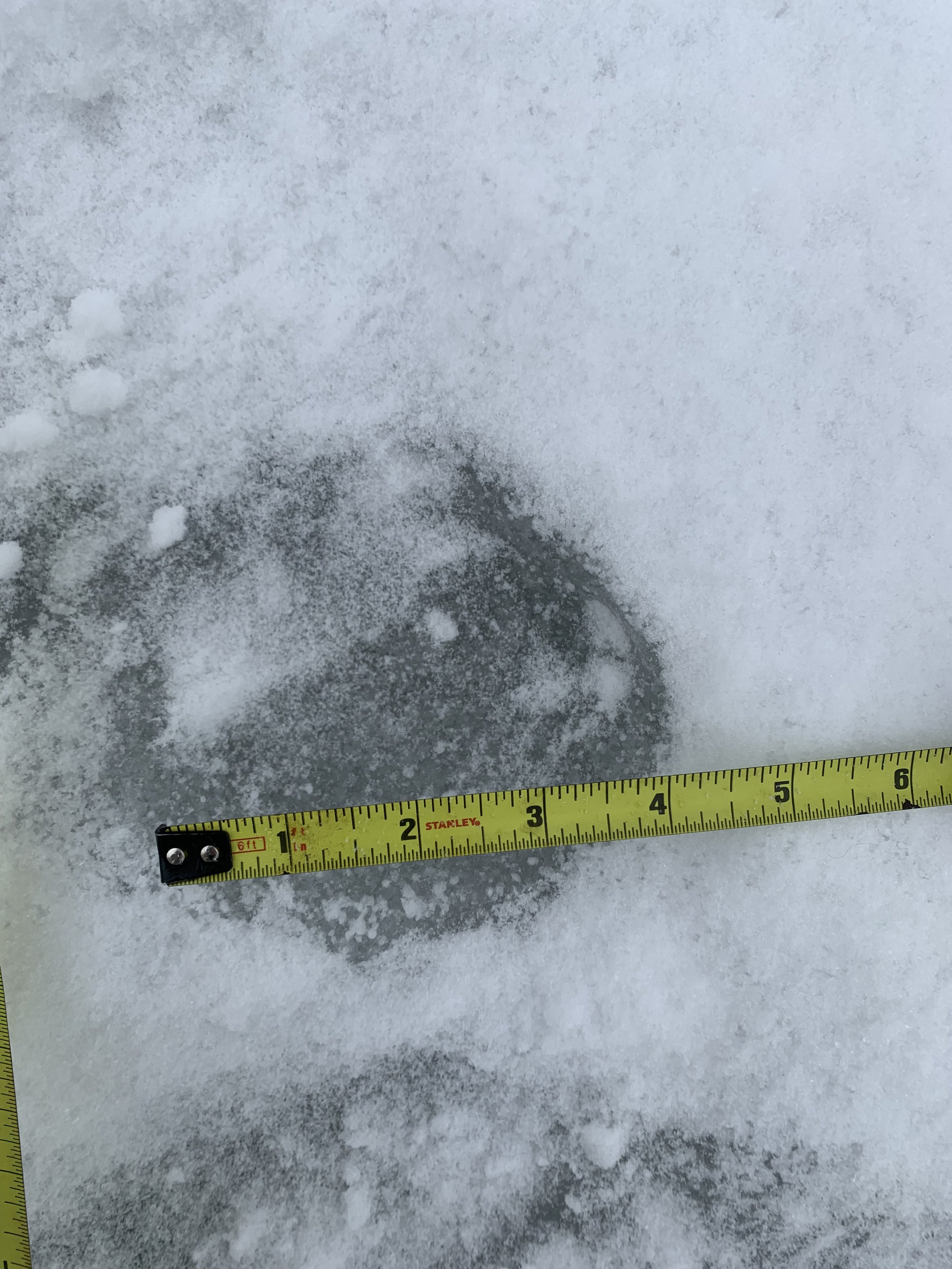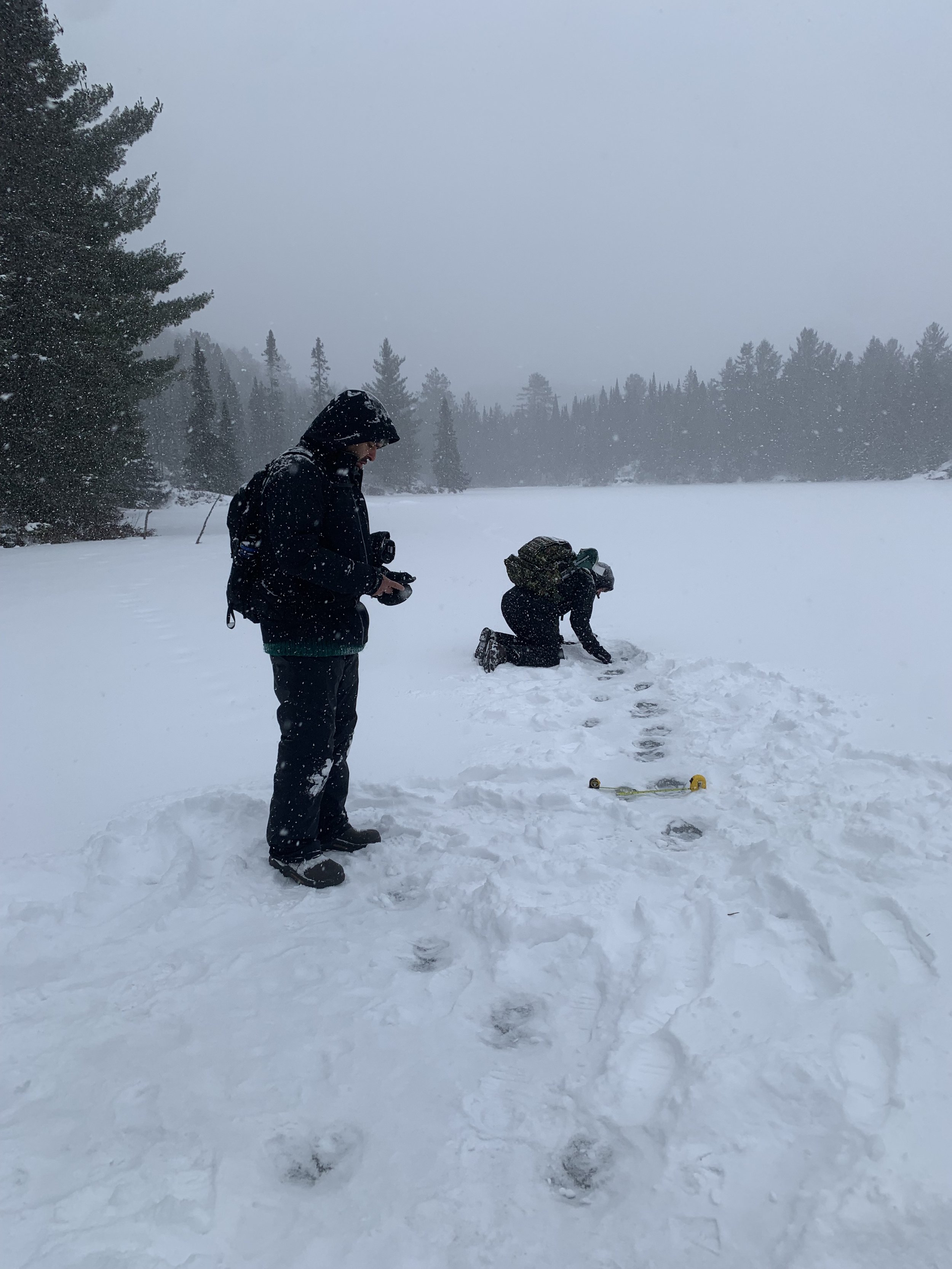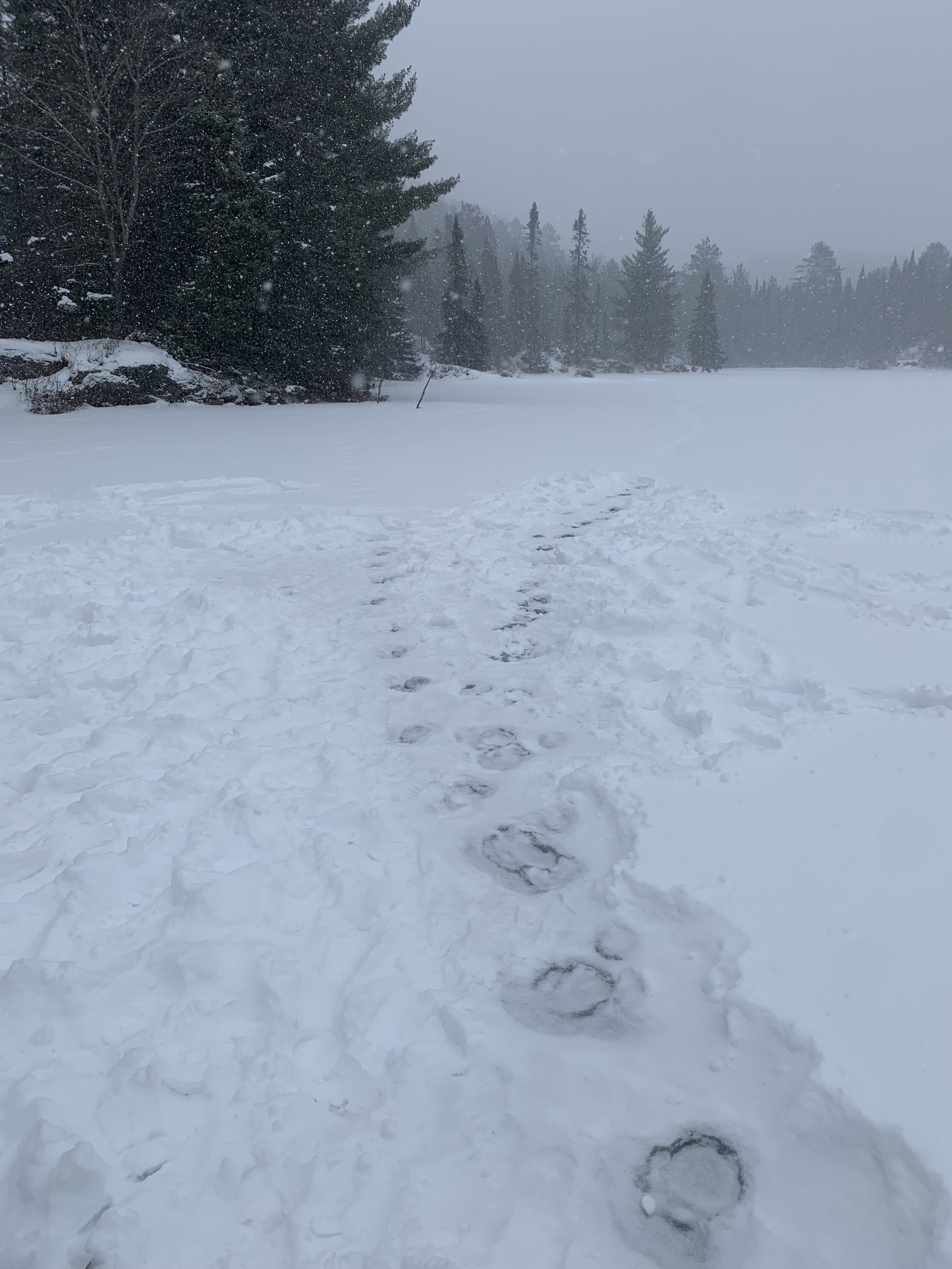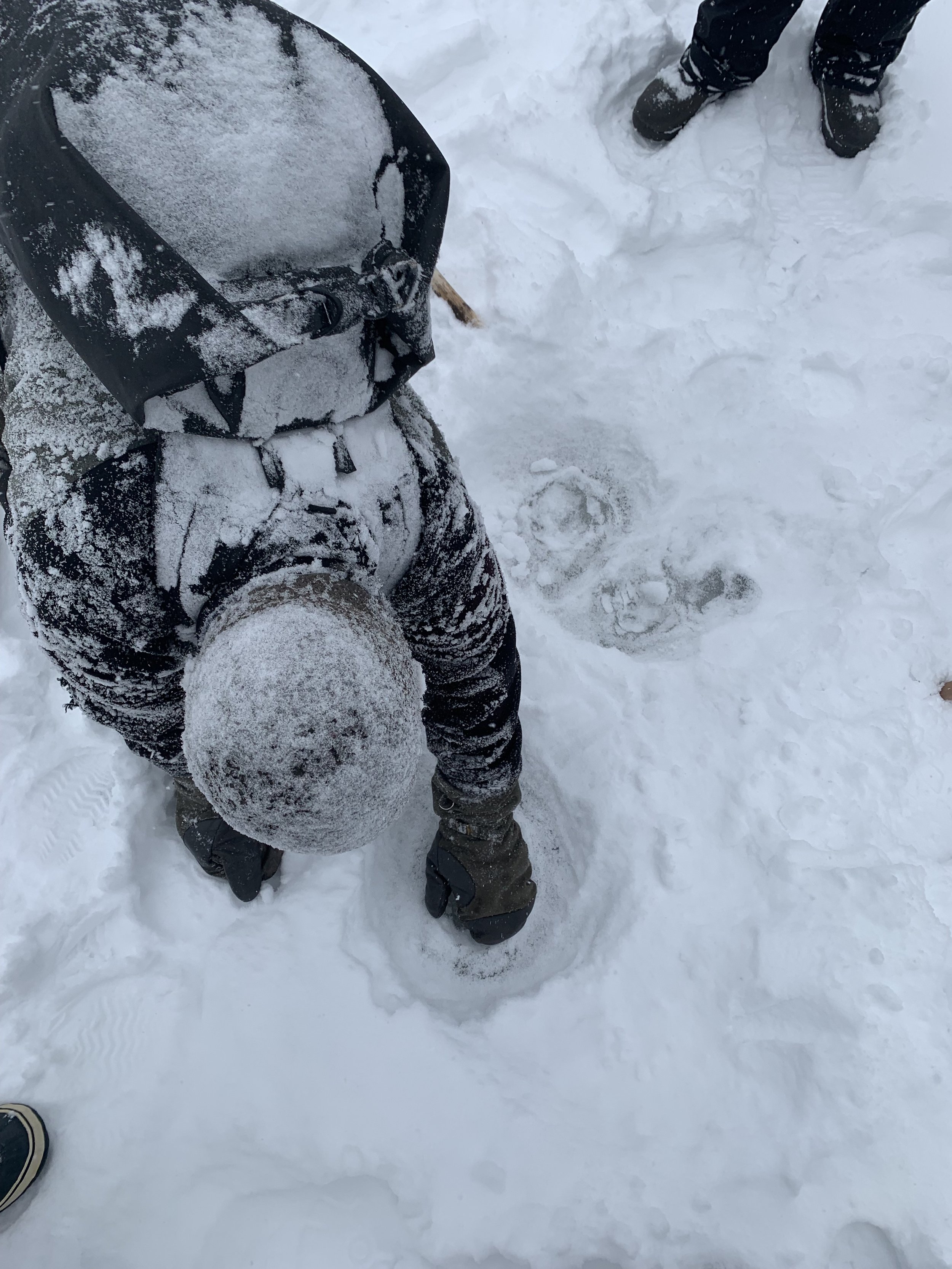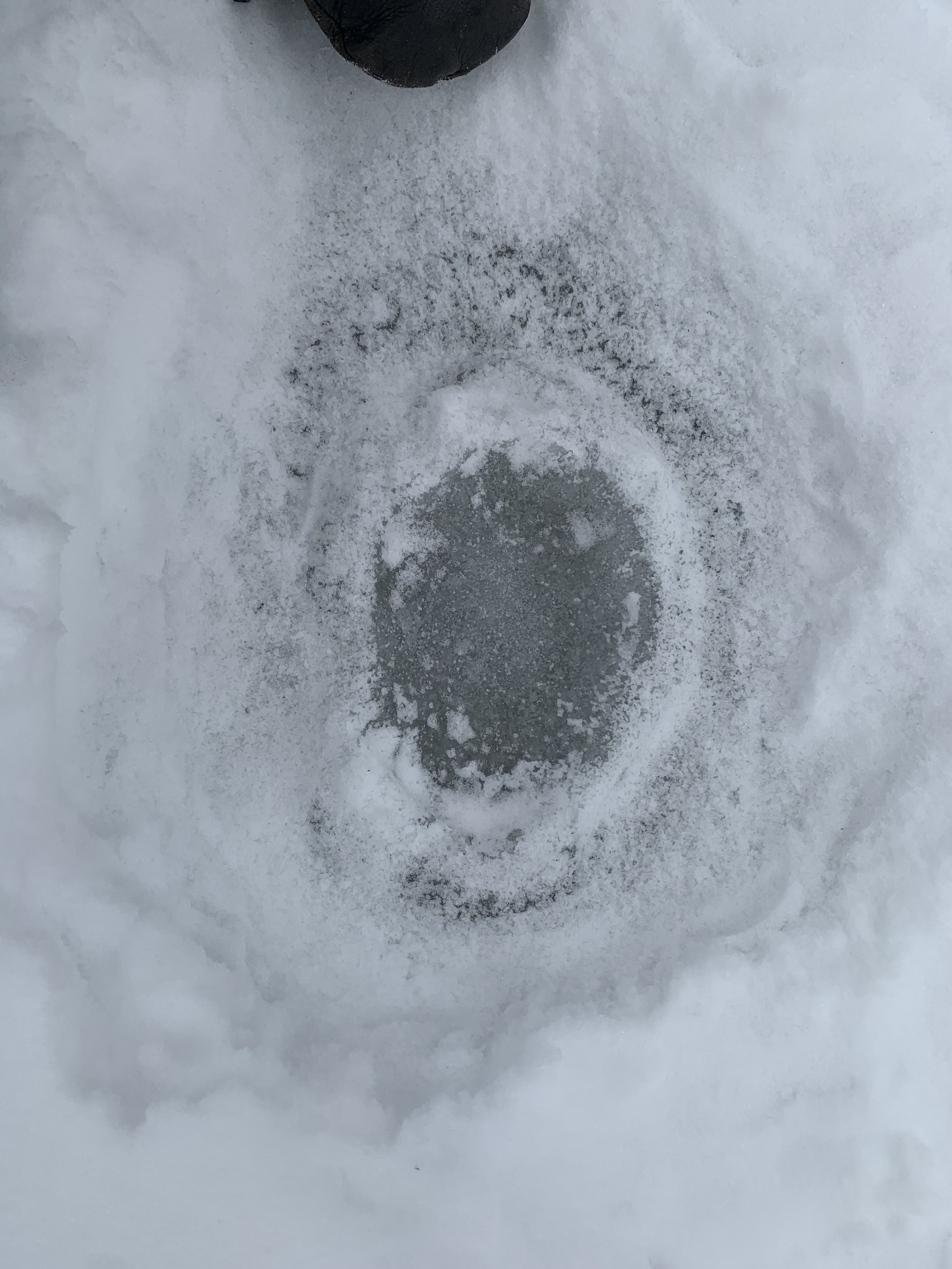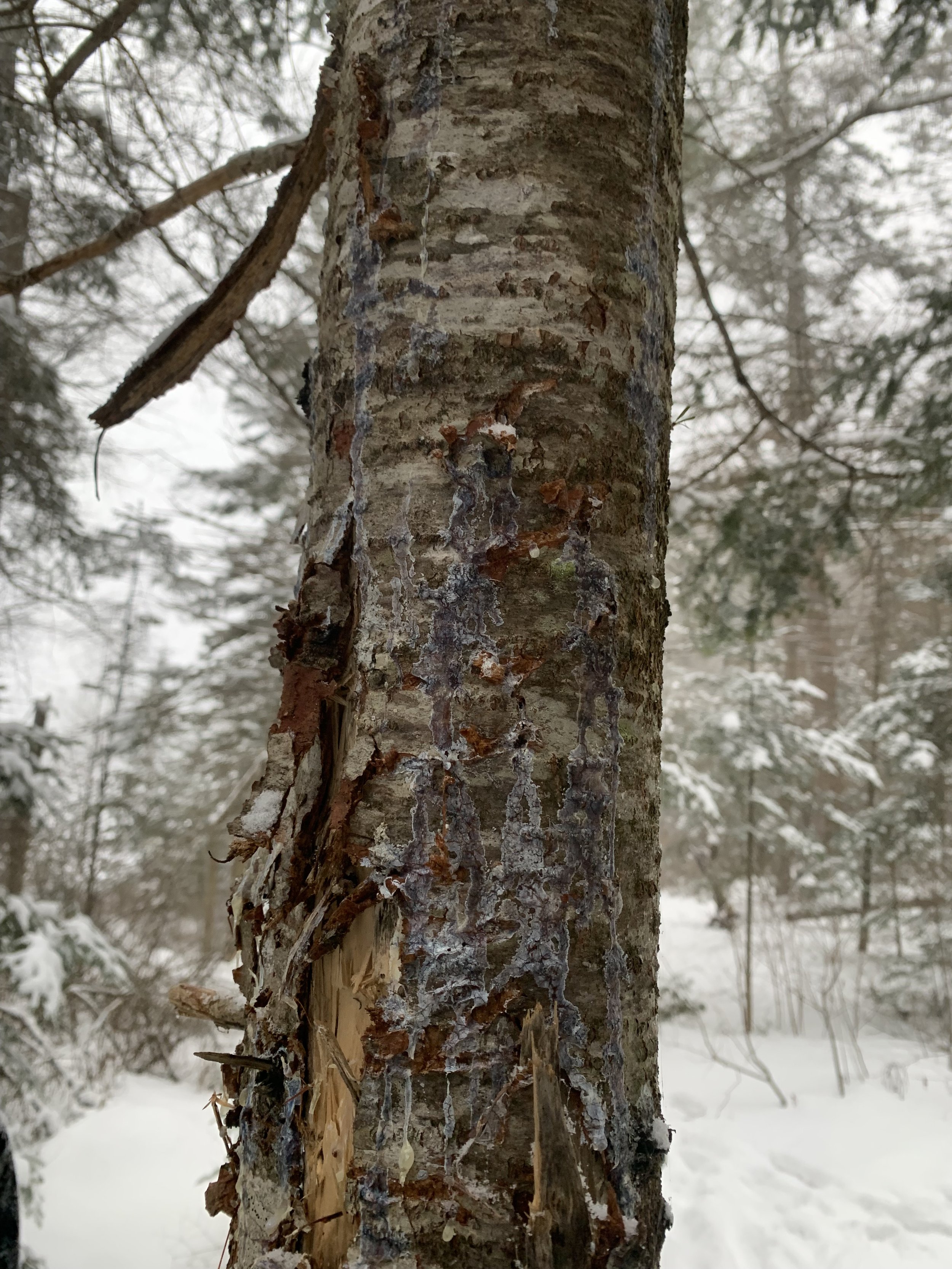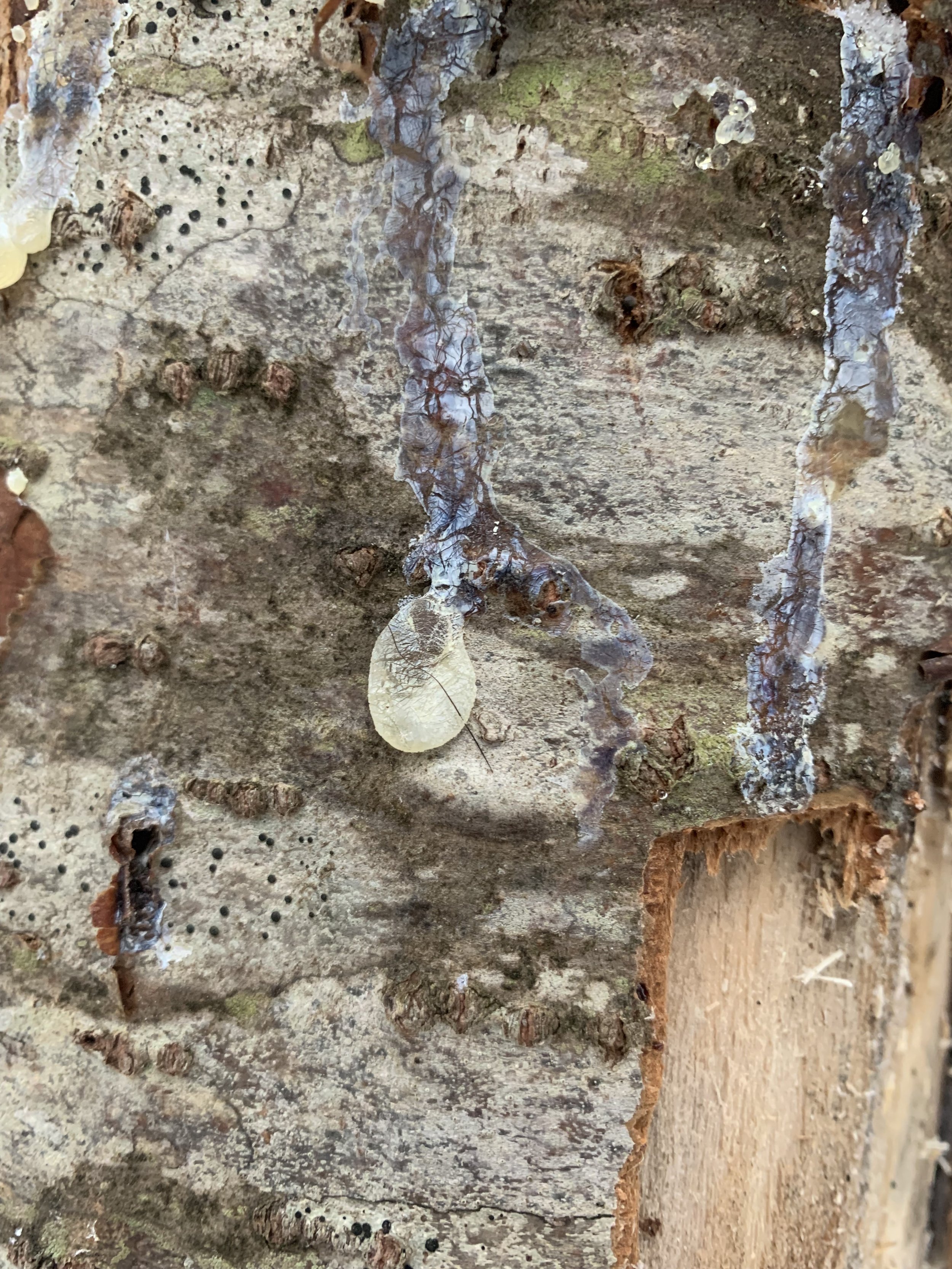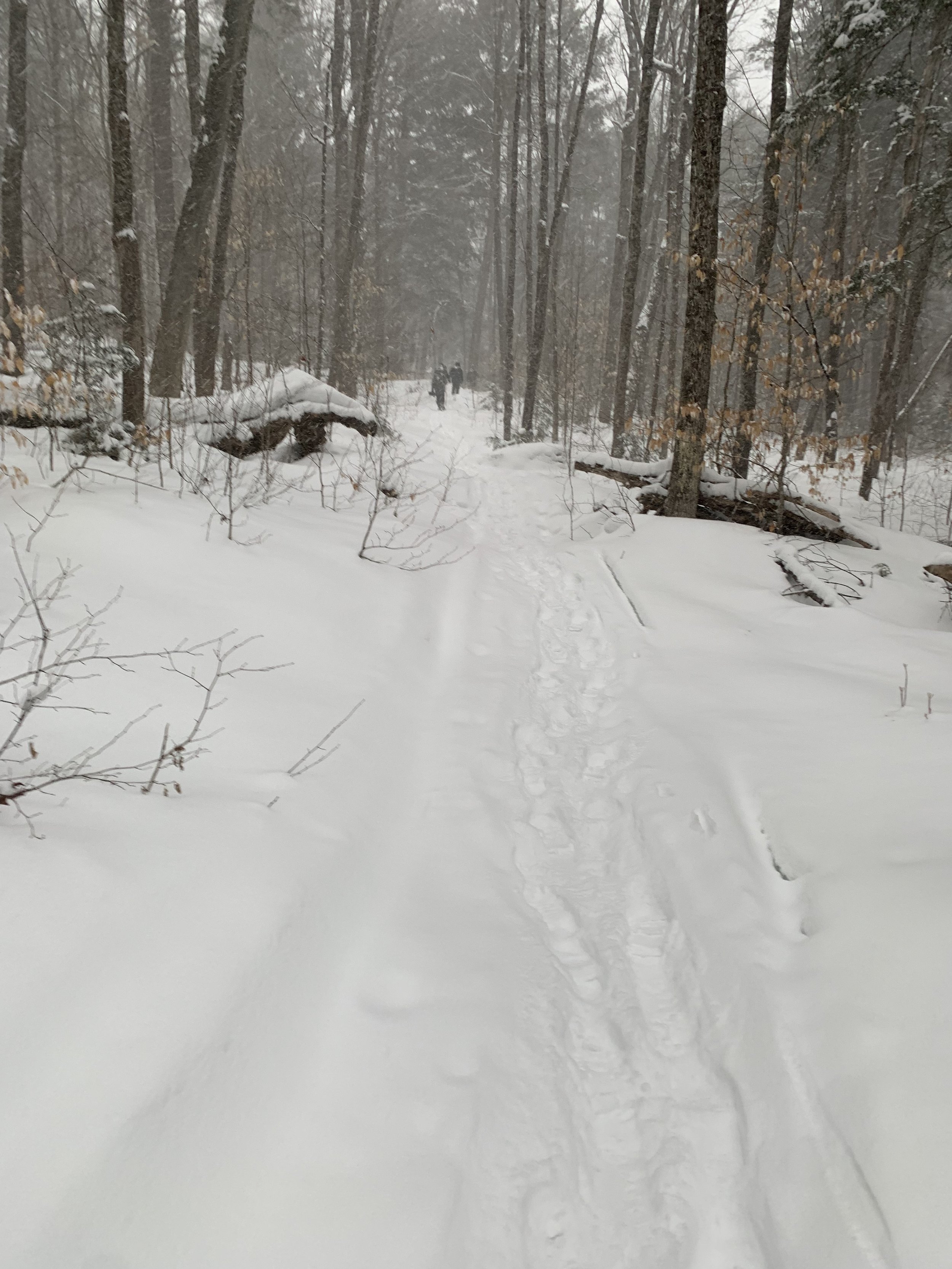Day 4: Algonquin Park 2024
Red Fox cache, flying squirrel sign, wolf tracks on the lake + inner child joy, & bear sign
Thursday February 17, 2024:
Right off the bat after getting out of the vehicles, we found our first tracks and trail of the day right before us.
Determining stride length for ID
The tracks were fresh from that morning. There had been a fresh bit of snowfall in the night, giving ideal conditions to spot any fresh disturbance to the snows surface.
Fresh fox track, clear enough to see the pads on the paw.
This trail crossed over the main walking path. We followed it forward, to see where the fox had gone.
Red Fox food cache
Very close by, Alexis discovered what seemed to be a cache.
A “cache”, being a location where a creature hides or buries food for later.
Digging into the cache a bit with the walking stick, it was determined that this was a cache.
The presence of blood in the snow, was a primary indicator. Further observing of the contents would tell us even more.
A good little piece of meat and what resembled rabbit scat. I wondered if this could have been rabbit meat that the fox had cached.
There was not much more to be found in the cache, other than some bloodied snow, and 2 hairs that I found.
2 hairs under a filed lense.
If you look closely, you can notice a colour difference between the 2 hairs.
One being darker/colorless and slightly longer, and the other orangey-brown and a bit shorter.
Being in no position to do a DNA test, however the orangey-brown colour was relatively suggestive of being from a fox. A very small piece of information, and a very exciting, and fun one, too.
It would mark sense also, as we identified the tracks as canine, too small for coyote or wolf, someones pat dog would be ruled out to, the track was too strait and clear, and also behaviourally showed the opposite traits of a domestic dog.
Fox was the best ID, and that fur was a great final piece of evidence.
Our small crew would now press on.
Beautiful ice crystals on the surface of a frozen pool of water.
Only very cold temperatures can create ice this beautiful.
Moving deeper into the forest, we had to check out a large hemlock tree we spotted admits the predominant hardwoods.
Squirrely-ness & food cache
I am unsure if you have ever seen this before, I know it was my first time.
It was one of the oddest and cutest things you could find on a hemlock tree.
Each photo is of a different cone wedged into a different part of the trees bark.
There were many more, beyond these 3 photos that I took.
I can’t recall who we decided it was, placing these hemlock cones intently. Squirrel is the most likely culprit here, to specify the species is a bit harder.
Reflecting on this day as I create this write-up:
It is neat that we found food cashes from 2 very different creatures, relatively close to each other in the forest, and in a short span of time.
Fox cacheing potential rabbit meat buried in a hole in the snow, fox style, and squirrel cacheing hemlock cones admits the bark of the hemlock tree, squirrel style!
Talk about winter preparedness and storage!
We did however begin to find more signs that would inform us that a flying squirrel was hanging out right where we were.
Squirrel homes
This was found in a hardwood tree very close to the hemlock. It was several feet from the ground, and below eye height.
This photo was taken in the day light, however I opted to use the flash on the camera to shed some light into the hole.
If you look really closely inside the hole, we can notice 2 details that are pretty fun:
First, there being fur stuck on the left side of the hole entrance, from a likely squirrel entering and leaving ( a likely place to find fur at a high use location), and secondly, tufts of moss close to the door at the middle/bottom of the inside of the hole.
Finding this hole was not a definite means to say this was a flying squirrel hole. It is possible, but we had no way of knowing for sure in that moment.
To say the least, we were tracking and learning a lot about squirrels.
What we found next however was clear evidence that a flying squirrel was close by.
Patagium & the lore of boxy-ness
Not only did we find a squirrel trail to follow for a bit, but we were also able to find a site where the squirrel came to a full stop in the snow.
This stop, provided evidence that this was a flying squirrel, and not a red squirrel, or other species of squirrel.
Width of trail is about 2.5”
Length is approximately 6-7”
I had heard from Alexis before this moment, in what was almost like a mythic tale, about the “boxy shape” that a flying squirrel makes at a stop in the snow due to its “squirrel wings” or what are actually called patagium.
Patagium, specifically being a membrane or fold of skin that unifies the forelimbs and the hindlimbs on gliding or flying creatures. Bats and moths both also have patagium.
Props to Byron, as I asked him the other day in between writing this section, what the proper term was for the “skin flaps” on flying squirrel.
Instead of a google search, I asked Byron, in person. Thank you Byron!
It was not until actually finding a stop, and looking at it pretty good, that the mythic tale became fine and true.
Flying squirrels truly, make a boxy shape when they stop in snow. Truly differentiating their track from that of other species of squirrel that do not fly.
To put it simply, the use of imagination is useful here.
Imagine a flying squirrel, with its squirrel wings, bounding through snow. The patagium, literally cut through the snow, on either side of its body, creating a straight edge in the snow from hind to front.
I will specify that the snow does need to be a few inches deep, and be soft and fluffy/fresh enough, in order for the patagium to register/leave an impression in the snow.
This results in the “boxy-shape”.
True fact and not myth!
Trick track, true track
Alexis pointed this out to our group as we walked down the trail, asking us what we thought about it, what it could be…
We all stopped, and began analyzing the heck out of this bizarre print…
What do you think it is?
After lots of consideration of it being made perhaps by small creatures, such as mouse, vole, shrew, perhaps a travel pathway to under that log- Alexis finally let us know what we were looking at.
It was made by a walking pole, or ski pole.
We all felt very played.
And, this was still tracking!
This is a great “trick” to experience or learn within tracking, identifying things that are not all made by wildlife.
It truly helps keep the mind open, to not limit ones perspective to only the world of wildlife. Tracks, and tracking, can be about anything and everything.
Great teachers like Alexis really keep you on your toes, and bring trickery and humour to your learning.
After some lunch, we continued down the trail, making our way towards the lake.
Wolf Howling Site
Before getting to Rock lake, a swath of older tracks were spotted, with a good dusting of snow overtop.
Right beside Rock Lake, at a higher point on a ridge that would drop down to the waters surface, perhaps a few days old, was a likely wolf howl site.
Tracks scattered all around this one small area, no scat, no blood, or anything leftover from a kill.
It was Alexis that really knew what had happened here, as I am not very experienced in tracking wolves, only when I am in Algonquin, further north in Ontario, or in British Columbia.
It does feel cool to stand where a group of wolves were hanging out or howling…
Making our way down to the lake.
You can get a sense of the weather by looking to the horizon. Snow, wind, and more snow.
It was actually very pleasant weather to be in!
Joy
What happened next would revert all of us 28+ year olds, into our inner child self.
Alexis dusting off snow from almost totally hidden wolf tracks frozen in the surface of the lake.
(Tip: if you zoom in, he has a smile on his face)
For this photo I encourage you to really take your time looking at it.
It is hard to notice at first.
These are 2 different trails, that are very snowed over. They both originate from one main trail, becoming 2.
This is indicative of big canines like coyote, and wolf.
We theorized that the howl site and these tracks were the same pack of wolves. It only really made sense, and the likely hood of these being made by 2 different packs was unlikely.
Another factor to consider was the age of both the howl site tracks, and the age of the tracks on the lake. Both snowed over, and a few days old.
We would spend the next 45 minutes feeling into so much joy with these wolf tracks, and simply dusting them off one track at a time.
Marcus dusting out some wolf tracks.
Feeling like little kids playing “archeology”, as the snow continued to fall harder and harder.
This is what we were uncovering.
Approximately 4” in length would be suggestive of the size for a wolf track too.
The beginning of the “fork” in the trail.
Clearing off the dividing point and continuation of the main trail into the now 2 trails.
It truly felt as though we were uncovering something very special.
This could have easily become one of those things you could do endlessly, and timelessly- and, it was nearing 4:00 pm, and we still had the trek back to the vehicles.
We followed the wolf trail down the lake a tad further before we would turn back.
But not without uncovering one more track…!
Curiosity and Wonder
We all couldn't seem to put down the how, the why, the what, and the when, of the creation, and formation of these wolf tracks on the surface of the ice.
Our small group spent a healthy amount of time using wonder and curiosity, as tools, to dream up what was going on with these wolf tracks.
How were they formed?
Why did they look the way they did?
Why was there a raised edge around each track?
Why could we not see an actual paw print?
Was the surface of the lake slushy when the wolves walked across it?
Did it melt and refreeze?
How many times?
Did the angle of the sun effect the aging of the track?
What about wind gusts?
Endless, insane, and amazing-
that all of this could be invoked by some wolf tracks frozen onto the surface of the ice.
This is what I live for.
Walking off the lake felt like how a young child might feel leaving the park.
I chose to walk at the back of the line with Alister, going at a slower pace, knowing our day, and the whole week, was coming to an end.
A slower pace + walking at the back of the group, allows for things to happen that may not happen in the middle of a group.
Bear sign
We had all walked past this tree on our way to the lake. It was right beside the trail at a corner where the trail turned to go up a bit of a hill, close to the waters edge.
Apparently a spot appropriate for a bear to mark up.
The sap was indicative of this tree taking some damage.
Claw marks in the bark on a pine tree.
This was at about my eye height, roughly 4-5 ft up the tree trunk.
If anything could have verified this was bear, it would be locating some fur.
The rest of the group was too far up ahead to check out the bear sign.
Alister and I continued our way up the trail, admits the continually falling snow.
Cold outside, and warm inside,
I was left feeling happy.
And that concludes Day 4
Leave a comment below!
And/or check out our final day of the trip, Day 5:
Bat Lake, winter tooth-brushing, grouse, fox, marten & some photography

